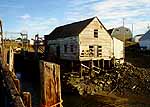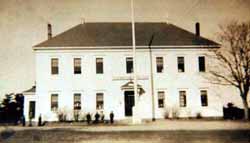Settlers:
In 1869 Green Cove was named Maitland in honor of sir Peregrine Maitland,
who was the Lieutenant Governor of Nova Scotia at the time. A village in
Hants County also decided to name their village Maitland, so since Green
Cove was a port, they named it Port Maitland.
 |
The earliest settler in Port Maitland is believed to have been Joseph
Sollows (1790-1869). while living there he built his first house and raised
six children. Where the wharf is now he had built a breakwater to protect
his boat, "The Sea Rover". He bought fish and started a general store on
the banks below the south wharf. Everyone in Port Maitland with the name
Sollows descended from him. |
Another settler was James Albert Rose. He settled in the southern end of
Port Maitland near Darling's Lake. His wife's name was Mary McGray. She
was the first person to act as a doctor in Port Maitland.
The great fire of 1820 in Beaver River increased the population of Port
Maitland considerably. It is said that all the houses within three miles
of the village were burned to the ground. Many of the people who lost their
businesses and houses moved to Port Maitland to set up again.
Shipping
Eleazer Raymond opened the first shipyard in Port Maitland at the foot
of Cove Street (now known as the "Shore Road"). One of the first ships
owned by a Port Maitland resident was the schooner "John Bull", built and
owned by Eleazer Raymond. It was probably the first ship built in Port
Maitland by the Raymond Family. Between 1860 and 1889, over 28 ships were
built at the Raymond shipyard. the industry fell into a decline in 1919.
the last sailing ship, a four masted schooner called "the Breakers" was
launched at Milton.
Farming
The farming in Port Maitland took place in the northern and southern ends
of the village. The first farmer was James Albert Rose. His land overlooked
Darling's Lake. In the northern part of Port Maitland the first farmer
was Nathaniel Sanders.
Mink farms were run in Port Maitland between 1940 and 1970 by George
and Vernon Sollows, Charles Fox, and Borden Hersey. Borden and Gilbert
Hersey had a mink farm between 1959 and 1971 in the spot where the Provincial
Beach park is now.
Schools
The first schoolhouse stood in a field now owned by Robert Crosby. It was
very small. The seats were made of slabs with rough, round sticks for legs.
There were no desks, and slabs were used for writing. It was destroyed
in a fire in 1859.
The second school was held in the Pitticus Temperance Diversion Hall.
It was in a field on the southwest corner of the Quaco Road and Main Street.
When the next school was built, all grades but primary were transferred
to it. The primary grades were taught there until 1902, when they were
accommodated in the remodeled fourth school.
The third school was built on the northwest corner of the Quaco Road
and Main Street. There were two rooms, one on the ground floor and one
on the top floor. The students now had chairs that were connected to desks.
Eventually it was sold and moved and used as a barn.
The fourth school was built in 1880 on the site of the third school.
There were two rooms on the ground floor. As the child population increased,
more room was needed so another floor was built. One of the upstairs rooms
was used for high school. The other room was called the Preparatory Room,
and was used for assemblies. During World war 2, the school was closed
due to a shortage of teachers.
|

|
 After
the new consolidated school was built in 1958, the schoolhouse was torn
down. the land now belongs to George MacAlpine. After
the new consolidated school was built in 1958, the schoolhouse was torn
down. the land now belongs to George MacAlpine. |
Picture contributed by Dot Vallillee
who attended this school from
Feb 1952 til June 1955.
|
The consolidated school is on the northeast corner of the Old Richmond
Road and Main street. There were ten classrooms, a large auditorium, cafeteria,
principal's office and a library. It went up to grade 8. 9-12 went to Yarmouth
High School.
In 1978 Maple Grove Education Center was built in Hebron for grades
7, 8 and 9.
Fishing
It is historically known the fishermen from the U. S., Portugal, Ireland,
England and France fished the Bay of Fundy and had summer homes along the
shore, to dry and salt fish.
One of the richest supplies of food and income came from the lobster
fishery. When steamboats and railways were made, catching and shipping
lobster became the most profitable business in the area. In1890, Atwood
Ellis and James and George Rogers started the catching of lobsters in Port
Maitland. They set traps near shore and hauled them by hand.
When gas engines came to use the boats could go farther and faster in
the exploitation of the lobster grounds. In 1947 number of trap set by
local fishermen was nine thousand, so the Department of Fisheries initiated
conservation methods.
Wharves
The first wharf was built by Joseph Sollows to protect his schooner, but
soon a larger one was needed.
In 1841, the sum of one hundred pound sterling was granted to build
a breakwater in Port Maitland. With this money the first part of the earlier
wharves was built. At various times additions were built on it until it
was large enough to accommodate the packet vessel, which made weekly trips
from St. John. It was also large enough to accommodate boats from Maine,
which came for cord wood. As trade and fishing increased, a lighthouse
was built at the end of the wharf in 1897. 
The north wharf was rebuilt in the early 1900's. A longer wharf was
started south of these in 1926 and was finished in 1929. This was called
the "new" wharf. It was built as a protection for the other wharves. It
worked in the summer, but not during rough weather.
In 1938 the north wharf was extended to join the south wharf, then towards
the "new" wharf. A part of the south wharf was removed to provide entrance
to the dock.
In 1940, vicious storms washed away over half of the "new" wharf. Between
1940 and 1949, the rest of it was washed away, and a new breakwater was
built next to it in 1949.
In 1954 the other wharf was surfaced in concrete and the sides were
remade with steel sheet piling. This part was removed in 1984. In 1979
Federal Department of Public Works called for the breakwater to be rebuilt.
In 1982 extensive repairs were made on the south wharf.
From Oct. 1983 to 1984 there was a $1.2 million project carried out
on the north wharf, reinforcing it and placing an armourstone wall on the
seaward side.
All the stuff in this was found in a book called Historical Trails compiled
by High Hopes Senior Citizens Club 1985.
Accommodation and Tourism
The first hotel in port Maitland was the "Maitland House". It was a stage
coach stop.
The house now owned by Carole Frost was Built by Josiah Ellis. He also
operated a fish firm and a general store. He bought what is now known as
the Ellis house property and remodeled it into a fin hotel, which was well
known in the 1900's. After he and his wife died the hotel was bought at
an auction by E. J. Baker of Yarmouth. It continued to operate until October
24, 1924 when it was destroyed in a fire.
Other hotels were the Mumford Lodge and the Maitland Inn. In the 1940's
Mr. and Mrs. Wilfred Sears operated the "Sears Cabins", across Main Street
from the Old Richmond Road.
Mr. and Mrs. Kenneth Sollows had tourist cabins across from where the
school is now. Mrs. Ivan Thomas later operated them until 1974.
In the late 1950's the tourism industry experienced a boom, because
many tourists were coming to Yarmouth, many asking about deep sea fishing
with rod and reel. In June 1958, Cecil Smith and Walter Thomas met the
requirements for a masters license to operate their fishing boats as charter
vessels.
Deep sea fishing was popular with tourists, who were able to catch cod,
pollock, haddock and tuna. Additional interest in the sport was aroused
by the Yarmouth Tourism association in the summer. Each summer they awarded
trophies for the largest fish caught, one for a man and one for a woman.
In recent years, the rising costs of equipment, gasoline and bait increased
the cost of chartering a boat and a decline in the number of tourists seeking
this type of diversion. |
